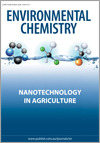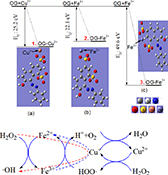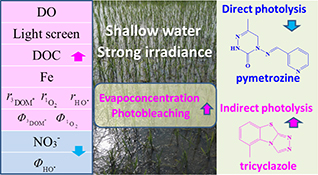Environmental context. Nano-enabled agriculture holds the promise of enhancing crop production while reducing the environmental impacts of agrochemicals. We review recent developments in the use of nano-fertilisers, nano-additives, nano-pesticides, nano-sensors, nano-cleansers and nano-delivery systems in agriculture. The review highlights the need for systematic studies on nanotoxicity and the development of cost-effective and eco-friendly nanomaterials for future applications.

Environmental Chemistry
Volume 17 Number 6 2020

Environmental context. Aromatic compounds are major organic pollutants that are hard to clean up by either adsorption or biological treatment processes. We synthesised Cu-doped Fe3O4 magnetic nanoparticles and showed that they efficiently degrade various aromatic compounds with H2O2 under mild conditions. This active and stabile heterogeneous Fenton-like catalyst has the potential for various environmental applications.

Environmental context. Photodegradation, a natural process for removing pesticides from water, is particularly important in rice fields with their large surface area and sunlight exposure. By studying two commonly used pesticides, we show that the properties of rice field water, such as dissolved organic matter, facilitate indirect photolytic processes while reducing direct photolysis. A better understanding of the natural degradation mechanisms for pesticides will inform their safer use in agriculture.
EN19189Soil sorption characteristics of benzobicyclon hydrolysate and estimated leaching risk in soils used for rice production
 , Erin M. Grantz, Matthew G. Sena, Jung Ae Lee, Kristofor R. Brye and Jessica A. Clarke
, Erin M. Grantz, Matthew G. Sena, Jung Ae Lee, Kristofor R. Brye and Jessica A. Clarke
Environmental context. The behaviour of herbicides in the environment is largely determined by the partitioning of the compounds between soil solids and soil solution. We determined that the rice herbicide-metabolite benzobicyclon hydrolysate partitions more into soil solution, and does so increasingly as pH increases. These results indicate that benzobicyclon hydrolysate is a risk for leaching in much of the rice-producing area in the US mid-South.
Environmental context. The detailed mechanism of hydrolysis of gas-phase ketene to form acetic acid is critical for understanding the formation of certain atmospheric contaminants. This study explores the effect of nitric acid and water on the hydrolysis of ketene in the atmosphere. The calculated results show that nitric acid is an effective catalyst in the hydrolysis of ketene to form acetic acid in atmospheric water-restricted environments.



